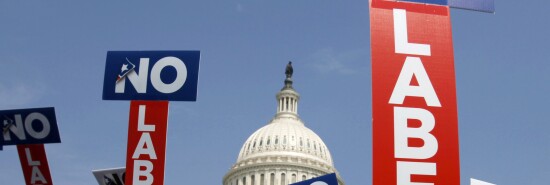
Why No Labels threatens Democrats in 2024
Ron Faucheux
Video Embed
There is a big, ugly fight playing out behind the scenes between Democratic Party leaders and No Labels, a centrist group that proclaims itself to be “an organization of Democrats, Republicans, and independents working to bring American leaders together to solve problems.” While No Labels is not a political party, it was founded to counter the influence of “extremes on both sides.”
The group is looking to support a centrist candidate for president, and it has enough fundraising firepower to be a player. Sen. Joe Manchin (D-WV), former Sen. Joe Lieberman, and former Govs. Larry Hogan, Jon Huntsman, and Pat McCrory all have ties to No Labels, and one of them could be its candidate.
GOP SENATORS WORK TO BLOCK BIDEN’S PLANS — LITERALLY
Democrats worry that a third-party or independent candidate from the center would split the anti-Trump vote. They theorize that former President Donald Trump has a hard base that can’t be penetrated, while President Joe Biden has softer support that could flee if there’s a third option on the ballot. This theory, of course, could turn out to be bunk.
One supposition that’s not bunk, however, is the layer cake theory: Third-party and independent candidates usually draw support in layers. The bottom layer may be mostly independents and voters who would not have ordinarily voted, the second layer may be mostly disaffected Democrats, and the third layer may be mostly disaffected Republicans (or vice versa).
A third candidate running up the middle could start off polling at 2% or 3%, taking votes primarily from independents and Democrats. But if that candidate rises to 10% or 12%, and more Republicans join the coalition, that would substantially alter its composition.
There are plenty of myths about elections. Since 1992, for example, many Republicans have blamed Ross Perot’s independent candidacy for destroying George H. W. Bush’s reelection chances. Perot drew 20 million votes nationwide, and Democrat Bill Clinton led Bush by nearly 6 million. But credible studies indicate that Perot was not a “spoiler” and drew as many votes from Clinton as from Bush.
It’s difficult to know 15 months in advance how a non-major party candidate will perform on Election Day. Many such candidacies tend to lose ground at the end of campaigns because voters don’t want to “waste” their votes on presumed losers, such as Libertarian Party nominee Gary Johnson in 2016. Others, however, strengthen at the end — which is how wrestler Jesse Ventura, an independent, won the election as governor of Minnesota.
The bitter memory of the 2000 presidential election, when Ralph Nader derailed Al Gore’s chances in critical Florida, continues to haunt Democrats. In that nail-biter, George W. Bush beat Gore by 537 votes in the Sunshine State. Nader, running on the left-wing Green Party ticket, received 97,000 votes statewide. If Nader had not been on the ballot, more of his votes would have likely gone to liberal Gore than to conservative Bush, thereby changing history. Continued anxiety over the Gore-Nader debacle has pushed Democrats leftward as a defense against third-party opposition.
In 2020, Biden won key states by tiny margins, including Georgia, Arizona, Wisconsin, and Pennsylvania. Democrats know they need to win those same states in 2024, and they don’t want any third candidate to interfere with that delicate process. But that’s also true about Republicans — some fear that if Trump is defeated for his party’s nomination, the unpredictable former president may himself run as a third-party candidate.
Democrats who complain about No Labels forget the basic reality of party competition: No party, Republican nor Democratic, can move too far right or left without risking heavy losses in the middle. If the Democratic Party hadn’t moved so far left in recent years, the votes it would lose to a centrist alternative would be greatly reduced.
The best defense for Democrats is not to attack No Labels, but to move to the center and temper their growing reputation as the party that represents only the Left. That may anger left-leaning interest groups, but it would expand the party’s voter base regardless of who runs.
Speaking of labels: Gallup polling last year found there were more independents (41%) than either Democrats (28%) or Republicans (28%). That should make both sides go hmmm.
CLICK HERE TO READ MORE FROM THE WASHINGTON EXAMINER
Ron Faucheux is a nonpartisan political analyst, pollster, and writer. He publishes LunchtimePolitics.com, a nationwide newsletter on polls and public opinion.
